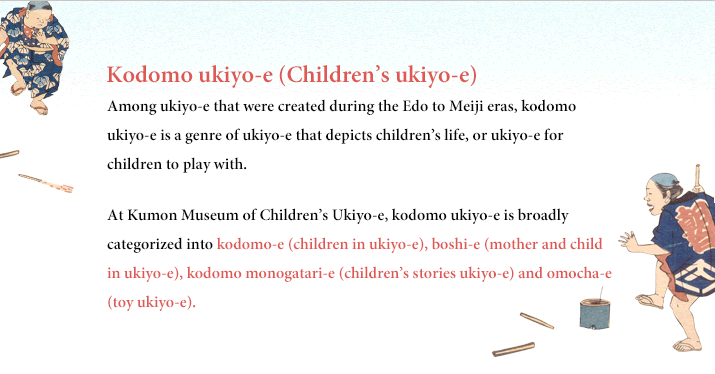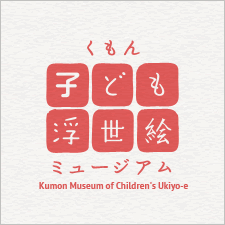Ukiyo-e by category


Furyu Junitsuki Shigatsu
[The Pleasures of the Twelve
Months: the Fourth Month]
Toyomasa
(Ishikawa Toyomasa)
A child-themed, decorative ukiyo-e, kodomo-e includes some mitate-e, in which contemporary figures were substituted for historical or occupational ones as well as characters from stories and theatrical plays. Kodomo-e is classified based on content as follows:
- Play
- Ukiyo-e prints that depict children at play.
- Lesson
- Ukiyo-e prints that portray children during lessons or practice sessions.
- Annual events
- Ukiyo-e prints that depict children at seasonal festivals and celebrations.
- Daily life
- Ukiyo-e prints that depict children in daily life and social life.

Kodakara Asobi Kamiyui
[Precious Children’s Play:
Hairdressing]
Kunisada
(Kochoro Kunisada)
A type of decorative ukiyo-e print that depicts the daily loving life of mother and child, including scenes of nursing, diaper-changing, bathing, hairdressing and playing with toys. The concept of "children are riches" can be found in many prints. As well as mothers, sisters and other women are often depicted in some prints and these are also considered boshi-e.

Koinu wo Hiku Kintaro
[Kintaro Walking with a Puppy]
Kiyonaga (Torii Kiyonaga)
A type of decorative ukiyo-e created for children to enjoy, such as "folktales, legends and creative novels" as well as "historical tales and biographies of great men." "Folktales, legends and creative novels" depict children’s heroes, such as Kintaro, Momotaro and Urashimataro, with monsters and ghosts being depicted in legends and fairy tales. "Historical tales and biographies of great men" include prints of warriors who existed and battle scenes.

Shinban Hinadana
Kumitate [Newly Published:
Ready-to-Assemble Dolls on
Platform for the Dolls’s Festival]
Kuninao
(Utagawa Kuninao)
A genre of ukiyo-e that children could cut out, paste, assemble and play with. Prints of buildable toys include kami-kosaku (paper crafting) and koma-e (an illustration within a larger picture). Kami-kosaku includes kumiage-e, a print that children can build three-dimensional models, and kisekae-e and anesama-e that were popular among girls. Kisekae-e is a modern-day paper-dress-up doll and anesama-e can be cut out to make an anesama doll. Koma-e was enjoyed by cutting out and assembling pages of a story to make a small picture book.

Fujin Ichidai Shusse
Sugoroku [Sugroku:
Womans of Success in life]
Yoshifuji
(Ipposai Yoshifuji)
A modern-day game that can be played and learned by several people at a time, which include esugoroku and karuta. Esugoroku is a game played by rolling dice and moving a piece forward to a goal according to the number indicated by the dice. Some esugoroku’s themes featured children’s growth and success, which could be learned through play. Karuta includes iroha-karuta and hyakunin isshu in which children could learn words and waka, a Japanese poem, through play. These are modern-day card games.

Mikake Wa Kowai Ga
Tonda Iihito Da [Looks
Scary But What a Nice
Person]
Kuniyoshi
(Utagawa Kuniyoshi)
A genre of ukiyo-e in which viewers enjoy the playfulness of the artist and solve hidden mysteries and riddles drawn in ukiyo-e.
- Monozukushi-e
- A print in which a group of objects related to a theme is drawn in one print, which serves as a reference or encyclopedia.
- Damashi-e
- A print that deceives the viewer’s visual perception.
- Gijinga
- A print that features animals instead of people.
- Kage-e
- A shadow picture that consists of shadow images of people and animals, as if light were cast from behind.
- Hanji-e
- A print of riddles in which people enjoyed guessing words from the pictures and letters drawn in the print.
- Moji-e
- A print in which Japanese letters are cleverly used as part of the design such as the outline of kimono.
Ukiyo-e that portrays scenes and culture of children’s life other than kodomo ukiyo-e are classified as follows:
- Bijinga
- A print that portrays a woman’s figure and her beauty.
- Musha-e
- A print that portrays strong heroes, heroic warriors, extraordinary characters, military generals and battles in history and legend.
- Yakusha-e
- A print of kabuki actors, theaters, and audiences watching kabuki.
- Sumo-e
- A print of portraits of sumo wrestlers, sumo matches and the ring-entering ceremony by sumo wrestlers.
- Fukeiga
- A print of famous sites and landscapes.
- Fuzokuga
- A print about the era, such as daily life and trends.
- Kyokunga
- A print that prepares the viewers for possible events that may occur in life.
- Fushiga
- A print that is intended to prompt or inhibit the change of the times.
- Kyozaiga
- Teaching materials and tools drawn by woodblock print.
- Others
















